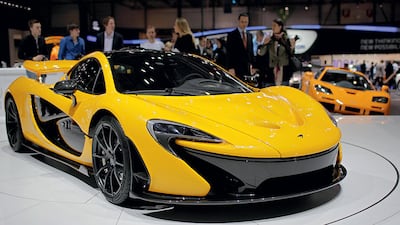The supercar is going through a bit of a revolution at the moment, with hybrid technology giving what many thought was an endangered species a second chance. Recently, The National was given a rare behind-the-scenes look at the development of arguably the most anticipated car of 2013, the McLaren P1, at the company’s headquarters in Woking, UK.
As a Formula One constructor, McLaren has prided itself on innovation, introducing carbon fibre monocoques to the sport and variable valve timing – with Honda’s help – in the early 1990s. So it’s not surprising that innovation is the plan of attack for its road car division.
Upon walking into the factory’s secured area, greeting us was the sight of the unpainted skeleton of a P1. It consisted of three pieces: everything from the windscreen forward as a single mould, the survival cell that houses the two occupants and the tail that takes in all the bodywork from just behind the driver’s head to the lights.
The survival cell, which also houses the battery and electronics, weighs a paltry 90kg; the complete rear section tips the scales at just 7kg, while I literally lifted the entire nose section with one finger. It weighs less than 4kg. Just over 100kg is the total body weight and yet, at its stiffest point, it’s more than five times stronger than steel.
A coat of paint will add roughly double the weight of the whole rear section, so expect a special naked carbon option following soon after its launch.
“We picked six different carbon fibres and 16 material formats,” says Claudio Santoni, the project’s principal engineer, “including unidirectional weaves to find the best compromise between safety and weight, so the interior carbon fibre is different to the body parts and the survival cell.”
Even the raw, lightweight body material delivered to the factory wasn’t light enough for McLaren’s weight obsessives. At 1.7kg per square metre, the team whittled it down to 1.5kg, while removing the clear-coat resin from the top layer of the interior’s carbon fibre saved an extra 1.5kg.
That’s about as much as you can say about the interior because, unlike the MP4-12C, which is plush by comparison, inside the P1 is a stark environment, though all the essentials are there.
“In Race Mode, the P1 develops 600kg of downforce at 250kph, and over one tonne at Vmax, thanks largely to the double-plane rear wing that uses exactly the same software as our F1 cars,” says vehicle dynamics manager Paul Burnham.
Power comes from a highly modified version of the twin-turbocharged, 3.8L V8 used in the 12C; this one develops 727hp. The company claims that it’s 90 per cent new, with a new crankshaft, fuel system, cylinder heads, block design, transmission and turbo systems. The turbo operates at around 980°C, with temperatures at the exhaust exit of around 900°C.
Gold leaf is used as a heat conductor around the exhaust, although that’s more of a hat tip to the original McLaren F1 road car, which used it extensively under the engine bay, as even the company admits that, after 20 years of development, there are better heat conductors than pure gold nowadays.
Partnered to this is the electric hybrid system that’s virtually identical to the Formula One Kers system called iPas. A button on the wheel gives a 176hp boost for overtaking, but it’s far more demanding in a road-car application than in Formula One motor racing.
“iPas in the P1 needs to be available continuously, whereas in Formula One it’s only used for seven out of every 100 seconds, so it has plenty of time to cool down, which is not the case with the road car,” the managing director of McLaren Electronic Systems (formerly TAG Electronics), Peter van Manen says.
All of this technology pays off in performance: the P1 gets to 100kph in just 2.8 seconds and 300kph in 16.5 seconds – 5.5 seconds faster than the F1 road car.
While no one can confirm exact orders just yet, not surprisingly, speculation says that the Middle East will get the highest number, and production will run at just one car down the line every day. The first P1 has already been delivered to a customer in the UK.
Follow us @LifeNationalUAE
Follow us on Facebook for discussions, entertainment, reviews, wellness and news.

